Greenbrier Games is not a company that likes to rest on its laurels, and every year it has a full schedule of board games to add to its eclectic and creative catalog. Their first release for 2019 is Champions of Hara, a collaboration between Greenbrier and the gents at Leafpile Media. After an initial run on Kickstarter back in 2015, Leaf Pile partnered with Greenbrier in 2017 to produce a bigger and better version of the game that featured all new assets, streamlined rules, and more. After a successful second run on Kickstarter, Champions finally has been released to the public, as well as its first expansion Chaos On Hara. We got a chance to talk with Walter Barber, one of the creators of Hara and co-founder of Leafpile, and get the inside scoop on one of Greenbrier’s most ambitious new endeavors.
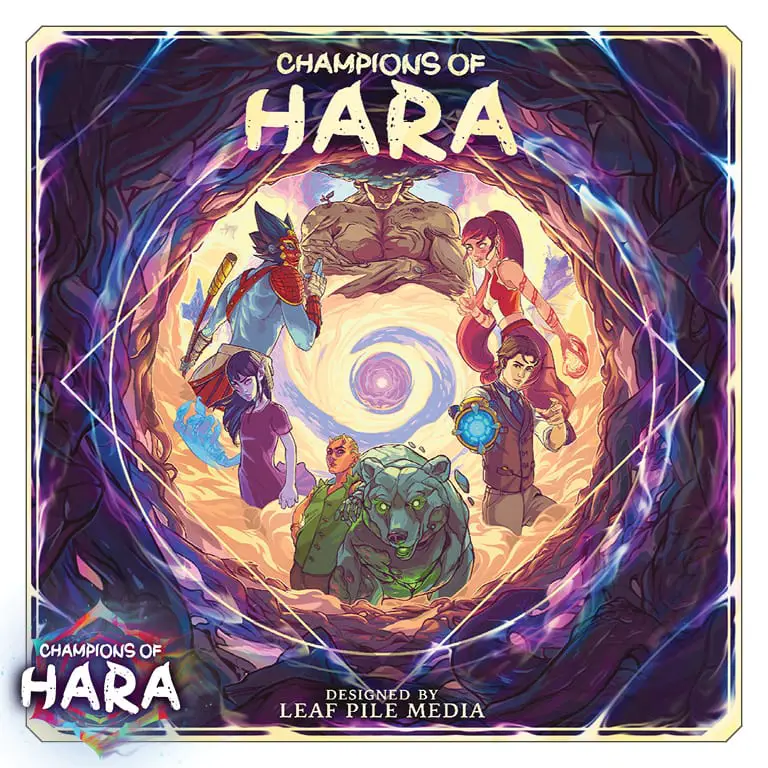
Dan Arndt: Let’s get something out of the way early: What is Hara, and who are the Champions?
Walter Barber: Hara is a dream-like, funk-fantasy world, located in “the belly of the universe.” The lifeforms that inhabit Hara are brought there from different worlds across the galaxy. They’re the downtrodden, dejected outcasts of their own societies, each struggling with trauma and personal demons. These individuals find themselves rescued from their darkest hours, the worst moments of their life, and whisked away to the world of Hara. The denizens of Hara speculate about the origins of their new home—some characters think it’s an afterlife, some claim it’s a place beneath the roots of the tree of life, others believe that Hara exists within the stomach of a giant monster. It’s a mysterious, beautiful place that imbues its inhabitants with magical abilities that reflect their individual creativity.
At first glance Hara seems like a paradise, but in actuality it is a deeply troubled world, repeatedly torn apart and reassembled by a cyclical, cataclysmic event known as the Conflux. In an effort to quell the destruction wrought by the Conflux, Hara’s stewards task the newcomers of the world with the burden of containing the wayward energy within his or herself by battling dangerous monsters and sealing explosive pockets of energy known as Rifts. As an incentive to help keep Hara safe, whomever collects the most of the renegade magical energy is reward with a nearly unrestricted wish to shape the world around them. Wishes, however, are never a simple matter; there are often dangerous repercussions to our heart’s true desires.
“Every aspect of Hara is intended to genre-bend”
DA: Where did the idea of this game come from in the first place?
WB: Champions of Hara is a lifetime of nerd-dom in the making, but the game and story didn’t start to formulate until the fall of 2012. The project was born out of my friendship with two brilliantly creative individuals—Ian VanNest and Andrew Zimmermann. The three of us lived together throughout college and spent most of our time immersed in comics and cartoons. I think we had just finished a hilariously epic four-against-four game of Magic: The Gathering when the decision was made to start working full-throttle on Hara. Sunday afternoon games were a lifeline in our chaotic lives, but something always felt missing without a story to get lost in. We knew we wanted to create a trans-media experience and build a narrative across games and graphic novels. We basically started ignoring our school work and social lives, and spent all our time working on the project. In our senior year we took first place in a business competition, gaining the seed money to bring Hara to life.
DA: What were some of the inspirations behind the world and story of Hara?
WB: When Hara was in its infancy, we were engrossed in shows like Samurai Champloo, Avatar The Last Airbender, and Adventure Time. Generic fantasy was abhorrent to us; our world needed to be off-beat, colorful, and subvert traditional tropes whenever it could. One of the guiding tenets of the project was to tell challenging, dramatic stories without letting the characters and the world take themselves too seriously. Media that stretched outside classic expectations are what really brought us together and energized the team; emotionally-charged hip-hop music, graphic novels about flawed heroes, and children’s cartoons with complex world building were our lifeblood. From the get-go, we wanted the gameplay to strike a balance between the gratification nature of strategic puzzle solving, and the excitement of exploration and discovery as you adventure throughout the world.
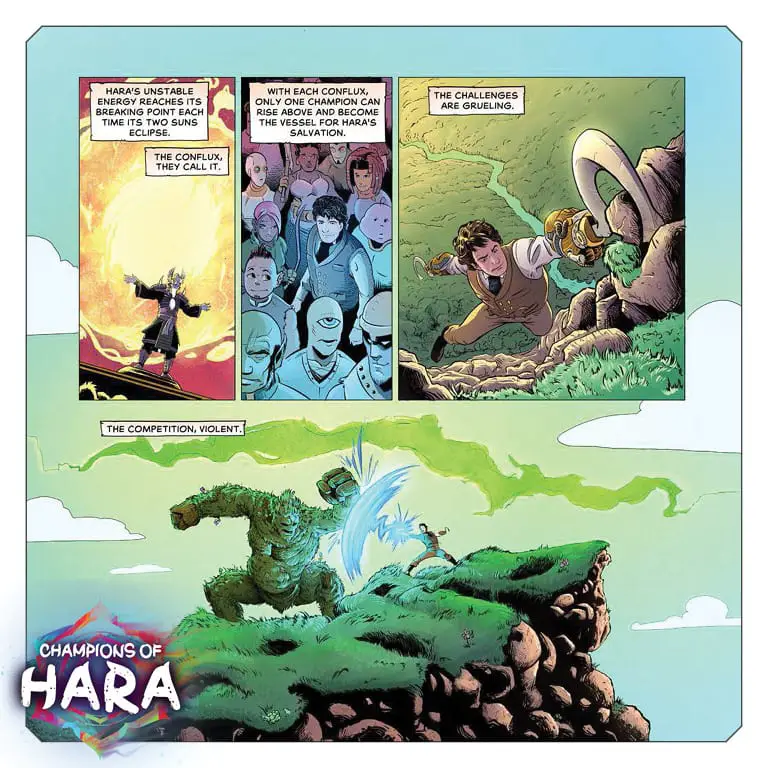
DA: Two short comics were released to promote the game, complete with covers. Why did you choose to use comics?
WB: Comics are an incredibly powerful storytelling medium. The ability to put sequential illustrations alongside prose is a liberating and genuinely fun way to share a character with the viewer. The goal of the Hara comics is to zoom in on each of the story’s main characters and offer a window into their (often difficult) backstories to give context to their unique mechanics and playstyles. The heroes that arrive on Hara are misfits and outcasts, struggling with human flaws we can all relate to. Sharing these stories via comic allows us to show instead of tell, and with each story we strive to use as few words as possible and let the art do the talking.
DA: It’s clear that a lot of care went into the look of the game. What feeling were you going for when you planned the art out for Hara?
WB: Every aspect of Hara is intended to genre-bend. Our aspiration with the art direction was always to mashup comic, cartoon, and traditional fantasy styles. Collaboration meant everything to us, and we worked with a diverse team of talented, young artists who put their hearts and souls into making Hara a unique world. One of the challenges we faced was the sheer amount of time that elapsed while working on Hara-–about six years from its initial conception to the game’s publication. In that time, the characters, the world, and the game mechanics took on a life of their own and evolved over dozens of iterations. Throughout that process, the illustrations and graphic design were along for the ride. Ultimately, I’m so proud of the way Hara looks, and so grateful for the immensely talented people who helped shape that vision.
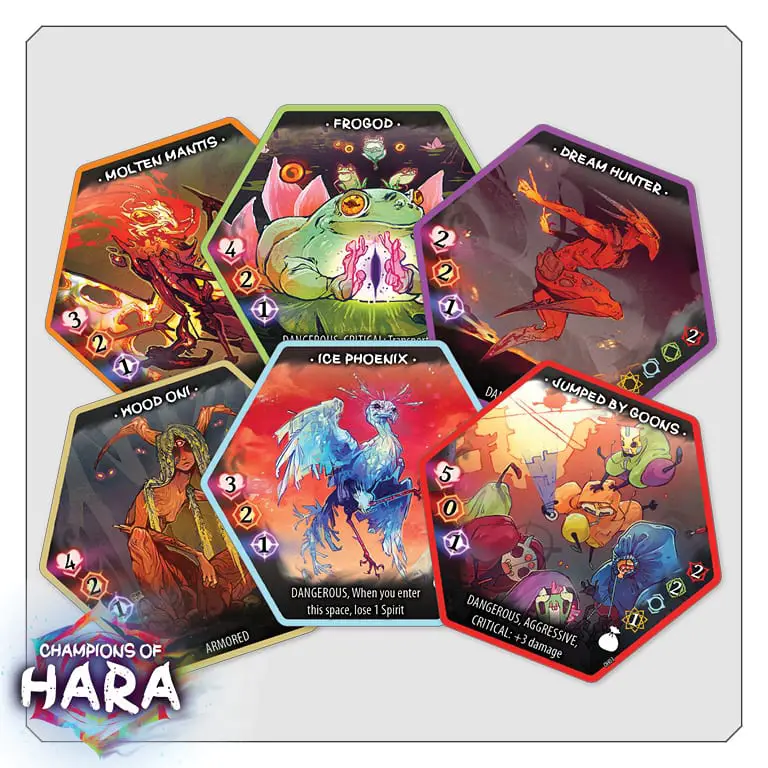
DA: Why did you choose to have both co-op (Scenarios) and versus (Arena) modes for the game? How hard was it to find a way to link the two, and why link them in the first place?
WB: As humans, I think we all struggle with our warring tendencies to both cooperate and compete. In Hara, all of the characters have their own motivations for wanting to win the Conflux and earn a wish, but they have these deep connections with one another and end up being forced to work together to overcome common problems. We wanted these characters to be complex, to really make people care about who they were playing as and to feel what their character is experiencing in the world. One of the most fun aspects of building Hara was dropping clues and snippets of narrative across the little windows of flavor text. As soon as we opened that up to cooperative scenarios, everything really came together from a storytelling standpoint. Mechanically, Hara is all about puzzle-solving, and co-op challenges felt like the purest form of that. Hara, however, is inextricable from conflict and strife, and we wanted to preserve the versus aspect of the experience.
“Hara’s core fan base has been with the game for years now, and our aim is to continue providing deep and engaging content for years to come.”
DA: The gameplay, especially the leveling up and ultimates, reminds me of a MOBA (Multiplayer Onlike Battle Arena). Were those games, or video games like that, something you thought about as you designed the game?
WB: One hundred percent! MOBAs, MMOs and “couch co-op” RPGs were some of the biggest influences on the design. The heart of all of these sub-genres is character development, customization, and asymmetrical abilities, so those were always in the focus during development. I personally loved MOBA games growing up (and still do), but always felt they were missing elements of narrative and exploration. For Hara, we wanted to preserve the dynamic “meta game” feeling, with a diverse roster of characters who not only had variations of their own playstyles to consider, but also interact with their competition in challenging ways. One of my favorite things to do in any game, digital or analog, is discovering a character’s “combos,” so we wanted to make sure there were plenty of opportunities for players to push that with Hara’s card-based mechanic.
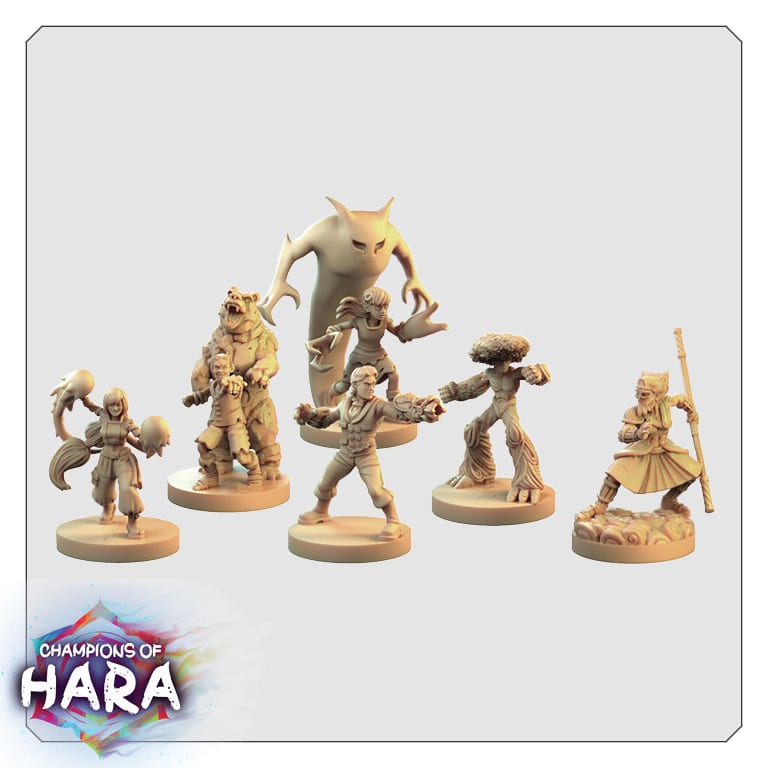
DA: How did you go about designing the various champions themselves, both in Champions of Hara and the expansion, Chaos on Hara? Do you have a favorite?
WB: Asymmetrical character powers were always the main event with Hara, but it wasn’t until a few years into the project that we came to the concept of unique resource systems for each playable character. It was challenging to make them all feel completely individual while simultaneously prioritizing balance, but at that point in the development the character’s already had such rich backstory and personality, that the initial draft of their different resource mechanics came organically. While the Chaos on Hara characters are some of my favorites (I especially love the expansion’s badass female leads, Thel and Ayako), I’m attached at the hip to the core six. Every character in Hara, even the minor ones, are inspired by important people in my life, but it’s no secret that I personally identify most with Kaoru and Kuma.
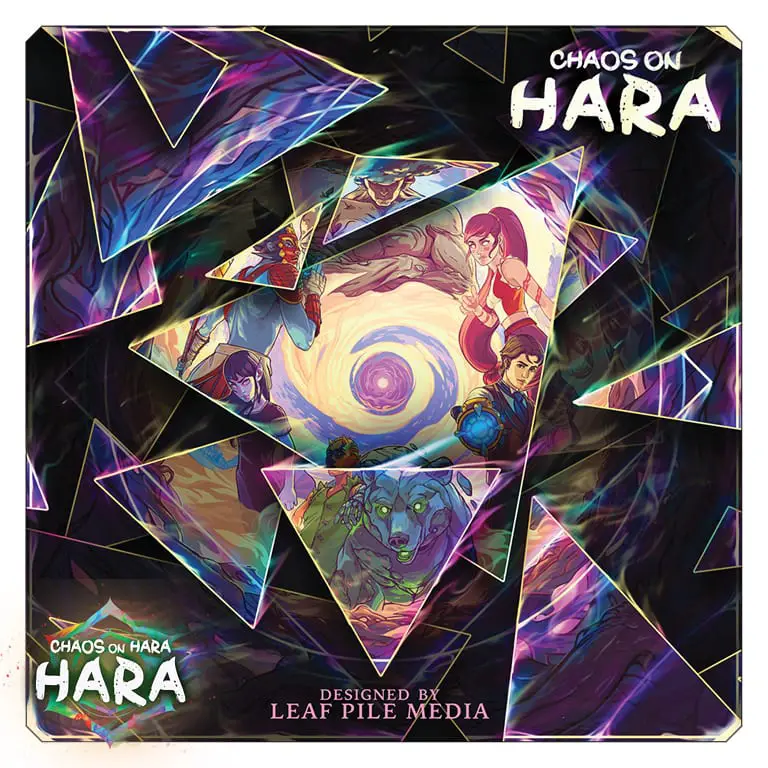
DA: Chaos On Hara features a crossover with another Greenbrier Game: Grimslingers. How was it integrating Icarus and the Witch King into the world of Hara?
WB: I make no bones about it—I am a major Grimslingers fanboy, and Stephen Gibson is one of my creative idols. He’s also the guy that put the final coat of paint on Champions of Hara and helped bring a cohesive look to all the different art styles at play in the game. I had the incredible privilege of helping to develop the Northern Territory expansion for Grimslingers and absolutely fell in love with the characters. Hara and Grimslingers have a lot in common: they’re both about misfit weirdos with complex emotions, both set in mysterious lost worlds, and both seek to balance lighthearted humor with gritty dark fantasy. Icarus and the Witch King are extremely rich characters, and it was so fun translating their powers and abilities into the Hara system. Mechanically, Icarus is very different from all the other champions, and including an outsider in the world gave us an opportunity to push some of the concepts in Hara to their limits.
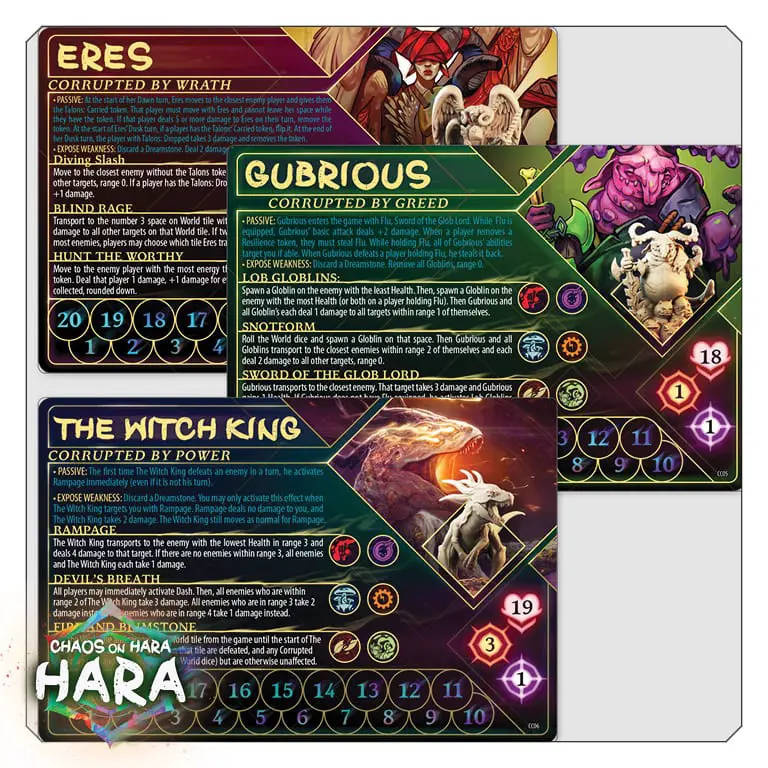
DA: Are there any plans for future expansions to Champions of Hara?
WB: Definitely! There is so much more story to tell. Not only is there more on the horizon for the Champions of Hara core board game, but the world will continue to unfold across different tabletop projects, comics, and—fingers crossed—other media. Hara is a huge space to play in, and our hope is to be able to continue to tell smaller, intimate stories alongside the major, game-changing events. Hara’s core fan base has been with the game for years now, and our aim is to continue providing deep and engaging content for years to come.
—
Champions of Hara and Chaos On Hara are both available from Greenbrier, retailing for $64.95 and $59.99 respectively. Champions of Hara: Beneath The Roots, a comprehensive lore guide to the world of Hara, is also available for download for $1.99. And finally, fans of Greenbrier’s Folklore: The Affliction can pick up Ame, Corrupted By Doubt, for use in either game, for $14.95.
What do you think of Champions of Hara? Will it be making an appearance at your next game night? Tell us in the comments! Keep checking back with The Fandomentals for new on Hara, Folklore: The Affliction, and the inside scoop on all things Greenbrier!

